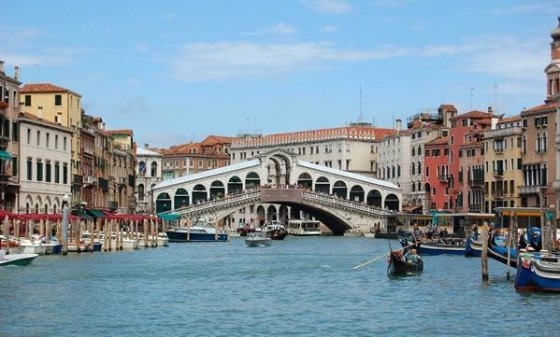
If the inconveniences of travel don’t bother you then the best time to visit Venice is in the fall. The tide rises and the banks are often overflowed. To see the flooding city knee deep in water is a unique experience. Maybe it is problem for the Venetians but for the tourists it is a magical moment. Tourists are often fascinated by the names that the different parts of this exotic city hold. For instance you ask a passerby about a certain direction. He will in all probability tell you to pass this calli, or take a left from this campi. These are but lanes, squares and important landmarks in Venice. Chances are important history of the city unfolded here or simply the job of the people who dwells in these squares and lanes. The all pervasive presence of the Gondolas enthralls tourists. Just imagine a ride with your loved ones on a chilly night in the Gondolas. If you ask me I will vouch by it. But more than anything else it is the Grand Canal and the Rialto Venice that are two most important and all pervasive feature of the region.
The original Rialto was a pontoon bridge built way back in 1181 by Nicolò Barattieri. The name then was Ponte Della Moneta maybe because it was near the mint of Venice. The thriving market on the Eastern side further increased the traffic of the bridge. Thus it was necessary to replace it with something more stolid, something that will hold the weight of the passersby. Hence in 1255 it was replaced by a wooden bridge. It was a movable bridge in the sense there were two inclined ramps meeting at a central section that could be moved and elevated if there was a possibility of a tall ship crossing the canal from this part. In the 15th century two rows of shops were added on the side of the bridge. From the rent, the state treasury funded the construction of the Bridge. The bridge was however burned in the Revolt led by Bajamonte Tiepolo in 1310.Again in 1444 the bridge collapsed unable to bear the weight of crowds that had gathered on that particular day to see a boa parade. Some proposed a stone bridge and plans were laid out by famous architects like Jacopo Sansovino, Palladio and Vignola.The stone bridge of the Rialto Venice that you see today is very similar in design to that of the original wooden bridge. It was designed by Antonio da Ponte. The covered ramps support lines of shops on the bridge. Some critics said that this would fall too. The bridge stands testimony to its engineering feat.

The Grand Canal below is the biggest of the canal in Venice. The snaking canal water lined up with age old heritage properties, markets, shops, and palaces is something straight out of The Merchant of Venice by William Shakespeare. The canal runs for nearly 2 miles. It is nearly 350 feet wide at the southern end of San Marco. This district was high end having luxury quarters. Houses were opulent and large. Typically, this section is known for its Renaissance grandeur. Merchants would describe this district as being advantageous to them. The Waterbuses is the best option to explore the Canyon. Don’t hesitate. Go take a ride of a lifetime.
As you are making your way through the network of Canals, high Renaissance architecture greets you from every corner. Palazzo Corner della Ca’Grande was built in the 16th century by Jacopo Sansovino. It is renowned for its Ionic and Corinthian columns. Today it is a prefecture. One passes through the Ponte dell’Accademia, which was previously a tiny iron bridge that was replaced later by a wooden bridge. By the time you will reach Palazzo Dario you are already awed at the many magic that the city is unfolding. The facede of this beautiful structure, belonging to the Renaissance, dates back to nearly 1488. The Galleria dell’Accademia situated on the canal is considered to be a seat of high art. It houses some of the 15th and 18th century paintings, which are considered priceless. The next beautiful structure is the Ca Grimani that was built by Sanmicheli in 1556. The high Ionian columns belonging to the exterior façade reveals more of the architecture belonging to the Renaissance period.